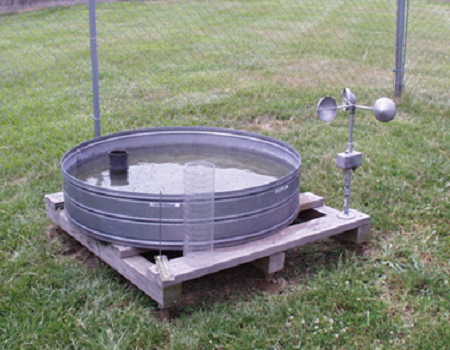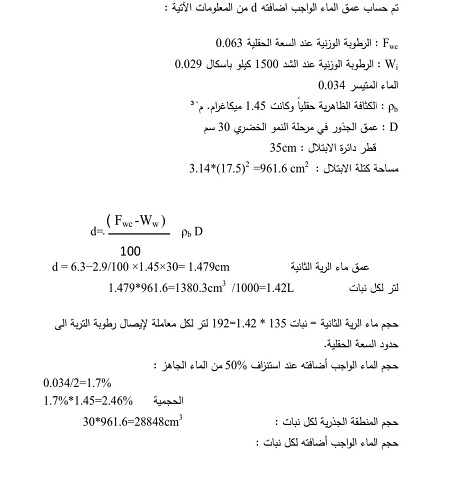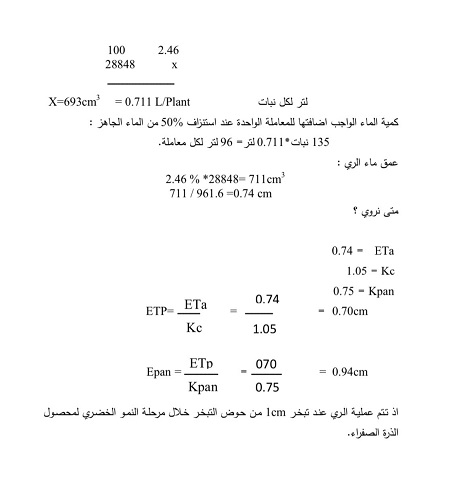| News Details |
When do we irrigate and how much water do we add?
2023-05-10

Assistant Instructor: Saleh Mahmood Saleh
Upper Euphrates Basin Developing Centre - University of Anbar
It is the science that is concerned with supplying agricultural areas with water necessary for agricultural uses in a manner that is accurately calculated on the basis of climate, topography, and soil nature, supplying the soil with water to maintain the moisture content necessary for plant growth, and washing the soil of excess salts, to maintain an acceptable salinity concentration in the plant root zone. Irrigation aims to replace the amount of water lost by both the plant and the soil. Water loss occurs through the process of evaporation from the surface of the soil to the atmosphere, and through the process of transpiration, that is, the loss of water by the plant from the stomata on the surface of the leaves. What determines the plants' need for water are two factors: the first is vegetative and the second is climatic. Thus, these two factors affect how water is used.
Factors affecting water needs:
The type of plant is one of the most important plant factors affecting water use. This is because plants differ in their water needs according to their type, as the amount of water needed to irrigate wheat differs from the amount needed to irrigate maize, for example.
The depth of the roots of the plant is also one of the factors that determine the extent of the plant's need for water, noting that good soil allows the roots to grow greatly in the depths of the soil. The deeper the roots go into the soil, the less water the plant needs.
As for the climatic factors that affect the quantities of water needed by different plants, they are summarized in the following four factors:
Firstlya:Temperature: The higher the temperature, the greater the plant's loss of water.
secondlya:Sun rays:Exposure of the plant to bright sunlight increases water loss through evaporation and transpiration.
Third: Moisture: Plants grown in a humid environment need less water than those grown in a dry or semi-arid environment.
Fourthlya:Wind: In general, the higher the wind speed, the greater the plant's need for water. So, different plants differ in their water needs. Trees need different amounts of water than vegetables. Also, different tree species need different amounts of water.
In addition, the nature of the soil is one of the decisive factors in determining the quantities of water needed for plants. As the intervals between irrigations are greater in the case of clay soil, because the latter’s ability to retain water is greater than the capacity of sandy soil, which therefore needs a greater number of irrigations and a shorter time difference. In addition to the type of plant, its age and size also have a significant impact on the amount of water needed for it. When plants in general, and trees in particular, are at the beginning of their lives, the amounts of water they need are less than those required by large trees.

Evaporation basin classA
We will calculate the irrigation time and the amount of irrigation water added using the evaporation basin class (A) American in two ways:
Firstly:Calculating the amount of water on the basis of calculating the wet mass of the roots and the plant density of the yellow corn plant using the drip irrigation method:
To answer the above question, the following must be known: soil holding capacity for water, water consumption, root zone depth, and available drainage.
To calculate the amount of water added, we take, for example, the yellow corn plant during the vegetative growth stage:


secondly: Calculating the amount of water based on the area of ??the field planted with yellow corn using the drip irrigation method.
|
How much water do we add?
V = a x d V = (52m×0.4m)×0.056m V = 1.1 m3 volume of water added per line
System operating time: V = q×t→→1.1 m3 x 1000 = 4.7 lh x 160 x t T = 1100 L ÷ 752 L.H→→T = 1.46 hours T = 1.46×60min = 88 min, the operating time of the system
|
Fwc: volumetric moisture at field capacity 32% pWp: volumetric moisture at tensile strength 1500 kPa 8.5% 1.32kg.cm bulk density³ D The depth of the roots in the vegetative growth stage is 30 cm Drip line 52m x 160m dotted Dripper discharge 4.7 liters/hour Irrigation when 50% of the available water is depleted
32-8.5 ÷ 100 x D = 7.05 Irrigation when 50% of the available water is drained:
D=7.05×0.5=3.52cm Washing requirements: LR = 0.06×3.52→=LR = 0.211 cm TID = (3.52+0.211)÷0.85= 5.56 cm
* When do we irrigate? Eta=d=3.52………………………………..1 ETa=ETo×Kc………………………………2 Substituting 1 into 2, we get: 3.52cm = ETo x Kc ETo = 3.52÷1.05 --→ETo = 3.35cm ETo = Epan x Kp→3.35 = Epan x 0.75 Epan = 3.35÷0.75 = 4.46c Epan = 44 mm
The irrigation process takes place when 44 mm of the basin evaporates |









